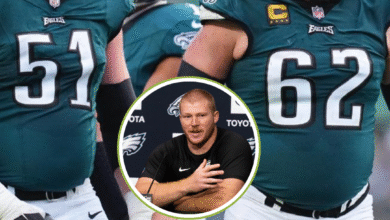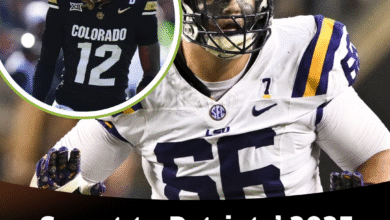Why Will Campbell Fits the Patriots Better Than Travis Hunter
OPINION: This article may contain commentary which reflects the author's opinion.
Why Will Campbell Fits the Patriots Better Than Travis Hunter
The New England Patriots stand at a crossroads with the No. 4 pick in the 2025 NFL Draft, tasked with accelerating their rebuild around quarterback Drake Maye. Two prospects loom large: LSU’s Will Campbell, a dominant left tackle, and Colorado’s Travis Hunter, a Heisman-winning two-way phenom. While Hunter’s versatility captivates, Campbell’s fit with the Patriots’ immediate needs and long-term vision makes him the superior choice, offering a solution to the team’s critical offensive line woes.
A Line in Crisis
The Patriots’ 2024 season exposed a glaring weakness: their offensive line. Allowing 52 sacks—the sixth-most in franchise history—and ranking 31st in pass block win rate, New England’s line failed to protect Maye, who faced pressure on 39.4% of dropbacks. Left tackle Vederian Lowe and right tackle Demontrey Jacobs were overmatched, with Lowe’s struggles particularly glaring. The result was a stunted offense, unable to sustain drives or maximize Maye’s potential.
Head coach Mike Vrabel, a former linebacker who values trench warfare, targeted the line in free agency, signing right tackle Morgan Moses and center Garrett Bradbury. Yet, the left tackle position remains unresolved, a priority Vrabel emphasized at the NFL owners’ meetings. The draft offers a chance to secure a cornerstone, and Campbell emerges as the ideal candidate.
Campbell’s Credentials
At 6-foot-6, 319 pounds, Will Campbell is a prototype tackle with elite athleticism. His 4.98-second 40-yard dash, 32-inch vertical jump, and 9.91 Relative Athletic Score highlight his rare movement skills. A three-year starter at LSU, Campbell allowed just two sacks in 994 pass-block snaps over his final two seasons, earning First-Team All-American honors and the SEC’s Jacobs Blocking Trophy. His 80.7 PFF run-blocking grade underscores his versatility in Vrabel’s run-heavy scheme.
Patriots brass, including EVP Eliot Wolf and Vrabel, view Campbell as a left tackle despite his 32 5/8-inch arm length, which some scouts argue better suits a guard. Vrabel dismissed these concerns, pointing to Campbell’s SEC tape against top edge rushers. “There’s the snaps at left tackle, evaluate it, and see what you think,” he said. NFL Network’s Daniel Jeremiah reported that Campbell is “really well-liked” in New England, with sources indicating he’s the likely No. 4 pick if Hunter and Penn State’s Abdul Carter are off the board.
Campbell’s versatility adds appeal. Wolf noted he could play tackle or guard, offering flexibility if his arm length proves limiting. His high floor as a Day 1 starter, with Pro Bowl potential, aligns with Vrabel’s emphasis on reliability.
The Hunter Hype
Travis Hunter is a once-in-a-generation talent. His 2024 Colorado stats—96 receptions, 1,258 yards, 15 touchdowns as a receiver; 35 tackles, four interceptions as a cornerback—earned him the Heisman Trophy. For the Patriots, Hunter could be a No. 1 receiver for Maye or a lockdown corner alongside Christian Gonzalez and Carlton Davis. ESPN’s Mel Kiper Jr. called him a “perfect fit” for New England’s roster holes.
Yet, Hunter’s fit raises questions. Vrabel suggested he’d focus on one position initially, likely cornerback, due to his slight 180-pound frame and the NFL’s physical demands. This delays his offensive impact, a priority for Maye’s growth. The Patriots’ recent defensive signings, including Davis, reduce the need for another corner, while the receiver room, though thin, could be addressed later. Posts on X highlight fan concerns, with some arguing Hunter’s two-way aspirations are unsustainable.
Why Campbell Wins
Campbell’s fit is rooted in necessity. A franchise left tackle is a non-negotiable for protecting Maye, whose 2024 season was derailed by constant pressure. Campbell’s immediate impact as a starter addresses this, enabling Maye to operate with confidence. His run-blocking prowess complements Rhamondre Stevenson, balancing the offense and easing pressure on McDaniels’ play-calling.
Hunter, while a game-changer, is a riskier bet. His offensive potential is tantalizing, but focusing him at receiver requires time to adapt, and his defensive role overlaps with existing talent. Former Patriots QB Brian Hoyer advocated for a receiver like Hunter, citing Josh McDaniels’ ability to scheme around tackle weaknesses. However, the Patriots’ 52 sacks suggest scheme alone can’t compensate for a porous line. As one X post noted, “A great O-line is the most consistent path to success.”
Campbell’s selection also aligns with Vrabel’s philosophy. His praise for Campbell’s SEC pedigree and athleticism reflects a preference for proven, physical players. Drafting Campbell allows New England to target receivers like Tetairoa McMillan in later rounds or via free agency, addressing multiple needs.
Building for the Future
Campbell fits the Patriots better because he solves their most urgent problem while offering long-term stability. At 21, he’s a potential 10-year starter, anchoring a line with Moses and Bradbury. Hunter’s ceiling is higher, but his role is less defined, and his impact is less immediate. As NFL Draft expert Daniel Jeremiah noted, Campbell’s selection feels like a “slam-dunk” if Hunter and Carter are gone.
In 2025, the Patriots need a foundation, not a gamble. Campbell’s ability to protect Maye and elevate the offense makes him the better fit, setting New England on a path to reclaim its place among the AFC’s elite.



